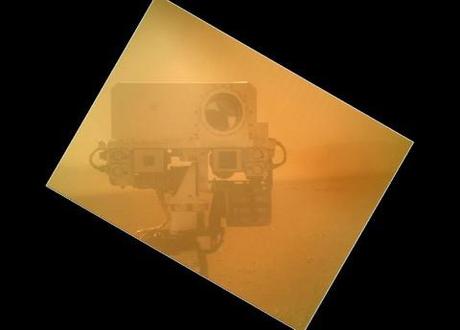 Wish you were here? Curiosity’s Self-Portrait. Photo Credit: nasa.gov.
Wish you were here? Curiosity’s Self-Portrait. Photo Credit: nasa.gov.
The background
One month into its two-year mission on Mars, NASA’s rover Curiosity has just beamed home a picture of itself. In other news, Curiosity has so far traveled over a football field in distance across Mars in its mission to discover if Mars has ever had or could have conditions making it suitable for microbial life.
The self-portrait
The Telegraph reported that Curiosity’s curious photographic behavior was actually not narcissism or shameless self-promotion, but a means of testing its robotic arms. Daniel Limonadi of NASA’s Jet Propulsion Laboratory, the lab behind Curiosity, told the paper: “We will be putting the arm through a range of motions and placing it at important ‘teach points’ that were established during Earth testing, such as the positions for putting sample material into the inlet ports for analytical instruments. These activities are important to get a better understanding for how the arm functions after the long cruise to Mars and in the different temperature and gravity of Mars, compared to earlier testing on Earth.” The Huffington Post noted that the rover also took calibration photographs to test its cameras: “including one of a penny which traveled all the way to Mars embedded in the rover.” NASA explained that the “MAHLI (Mars Hand Lens Imager) adjustable-focus, color camera at the end of Curiosity’s robotic arm can be used for taking extreme close-ups of rocks and soil on Mars, as well as images from greater distances.”
The ‘Sam’ Test
Besides taking photos of itself, Curiosity has been busy analysing the chemical atmosphere of Mars. Curiosity’s Sample Analysis at Mars instrument, known as ‘Sam’ to its mates, is a crucial component of the ground-breaking rover. Curiosity will be sucking in air to Sam, which is designed to reveal the different concentration of gases on Mars. The study into the chemistry of Mar’s atmosphere is the first conducted since the Viking landers in the 1970s revealed that C02 is the main component of the air on the red planet.
What’s it looking for now?
Curiosity’s deputy principal analyst Joy Crisp told The Daily Mail that the mission is looking for traces of the short-lived gas methane: “When Sam is at its best it can measure various parts per trillion of methane, and the expected amounts based on measurements taken from orbit around Mars and from Earth telescopes should be in the 10 to a few 10s of parts per billion.” BBC News noted that the rover’s analysis of methane levels on Mars could result in a scientific breakthrough: “The gas has recently been observed by satellite and by Earth telescopes, and its presence on the Red Planet is intriguing. Methane should be short-lived and its persistence suggests a replenishing source of some kind – either biological or geochemical.”
Life on Mars?
The Guardian’s Stuart Clark noted that, “It is difficult not to get excited about Nasa’s Mars Curiosity Rover. It’s the most ambitious exploration vehicle yet sent to Mars. It has more instruments than any previous rover and the scientific harvest from its two year mission inside Gale Crater could help reveal the planet’s climate history and whether there was once a habitable period.” The project is also tremendously exciting for NASA’s Curiosity team. The New York Times visited their office and spoke to Curiosity driver John Wright, who told the paper: “We definitely win the coolest job contest at cocktail parties. What do you do? Oh, you’re an investment banker? Isn’t that special, I drive on Mars.”
More on Curiosity and space
- will.i.am reaches for the stars, or at least, the Red Planet, with first song blasted from Mars
- What you need to know about the Curiosity Rover
- Sally Ride, first US woman in space, dies at 61

